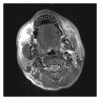Infectious mimicry complicates diagnosis in hemophagocytic syndrome caused by anaplastic large-cell lymphoma
- PMID: 22761627
- PMCID: PMC3385285
- DOI: 10.1155/2012/968706
Infectious mimicry complicates diagnosis in hemophagocytic syndrome caused by anaplastic large-cell lymphoma
Abstract
Hemophagocytic syndrome (HPS) arises secondary to genetic, rheumatologic, neoplastic, and infectious causes. We discuss a patient whose presentation was consistent with systemic infection but was discovered to have HPS of unknown etiology. The presenting symptoms, as well as unremarkable malignancy and rheumatologic workups, led to the pursuit of an infectious cause, but the patient was ultimately discovered to have an occult anaplastic large-cell lymphoma (ALCL). This case demonstrates the diagnostic challenges that result from infectious mimicry in the context of HPS-first, in distinguishing noninfectious HPS from the systemic inflammation that can result from a widespread infectious process, second, in the identification of the precipitating cause of HPS. While evidence of these challenges has been suggested by the limited literature on HPS and ALCL, our case illustrates the diagnostic dilemma that arises when tissue biopsy does not quickly reveal an etiology. It is important that all physicians be aware that HPS can mimic infection and be prepared to redirect the workup when an infectious etiology for HPS cannot be identified.
Figures



Similar articles
-
Collapsing glomerulopathy associated with hemophagocytic syndrome in a patient with NK/T cell lymphoma.Clin Nephrol Case Stud. 2016 Jun 27;4:11-17. doi: 10.5414/CNCS108586. eCollection 2016. Clin Nephrol Case Stud. 2016. PMID: 29043136 Free PMC article.
-
Anaplastic T-Cell Lymphoma Associated with Hemophagocytic Syndrome: A Case Report.Turk J Haematol. 2003 Jun 5;20(2):101-6. Turk J Haematol. 2003. PMID: 27265440 English.
-
Hemophagocytic syndrome associated with inappropiate secretion of antidiuretic hormone in lymphoma and acute myeloblastic leukemia: report of two cases.Leuk Lymphoma. 2001 Nov-Dec;42(6):1401-4. doi: 10.3109/10428190109097769. Leuk Lymphoma. 2001. PMID: 11911425
-
[Eperythrozoonosis complicated with hemophagocytic syndrome: report of four cases and review of literature].Zhonghua Er Ke Za Zhi. 2018 Apr 2;56(4):303-307. doi: 10.3760/cma.j.issn.0578-1310.2018.04.013. Zhonghua Er Ke Za Zhi. 2018. PMID: 29614573 Review. Chinese.
-
What nephrologists need to know about hemophagocytic syndrome.Nat Rev Nephrol. 2009 Jun;5(6):329-36. doi: 10.1038/nrneph.2009.73. Nat Rev Nephrol. 2009. PMID: 19424103 Review.
Cited by
-
COVID-19: to be or not to be; that is the diagnostic question.Postgrad Med J. 2020 Jul;96(1137):392-398. doi: 10.1136/postgradmedj-2020-137979. Epub 2020 Jun 10. Postgrad Med J. 2020. PMID: 32522844 Free PMC article. Review.
References
-
- Henter J-I, Arico M, Egeler RM, et al. HLH-94: a treatment protocol for hemophagocytic lymphohistiocytosis. Medical and Pediatric Oncology. 1997;28(5):342–347. - PubMed
-
- Henter JI, Horne A, Aricó M, et al. HLH-2004: diagnostic and therapeutic guidelines for hemophagocytic lymphohistiocytosis. Pediatric Blood and Cancer. 2007;48(2):124–131. - PubMed
-
- Janka GE. Familial hemophagocytic lymphohistiocytosis. European Journal of Pediatrics. 1983;140(3):221–230. - PubMed
-
- Aricò M, Janka G, Fischer A, et al. Hemophagocytic lymphohistiocytosis. Report of 122 children from the International Registry. Leukemia. 1996;10(2):197–203. - PubMed
-
- Janka GE. Modern management of children with haemophagocytic lymphohistiocytosis. British Journal of Haematology. 2004;124(1):4–14. - PubMed
LinkOut - more resources
Full Text Sources

